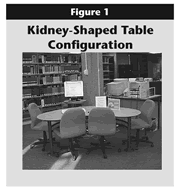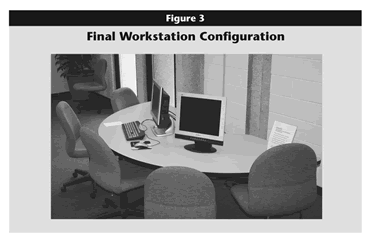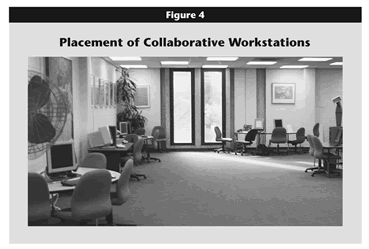Anyone who spends time on a university campus will notice the number of students working collaboratively on projects. These students often encounter problems finding a place with both space and equipment to support their work. Collaboration usually is also a bit noisier than other coursework. Although the library is often a main meeting place for students, libraries traditionally have not provided either space for or an atmosphere conducive to collaborative activities.
Indiana State University (ISU) is a medium-sized comprehensive university with about 9,000 students. The library provides a wireless environment with over 70 public personal computers on five floors. Students use the library heavily, especially as a place to work both individually and in groups. The question for librarians at ISU was, how can libraries provide support that makes effective collaborative learning possible?
Project Plan
In fall 2002 a team of librarians and staff was organized to develop and evaluate collaborative workstation prototypes for the ISU library. We knew that ISU did not have the resources to develop collaborative learning spaces requiring extensive construction. Instead, we chose to explore models for a low-cost collaborative workstation. We had the initial goal of providing four workstations for students in the library. We determined that such a workstation must seat three to six students around a personal computer and monitor. We developed several collaborative workstation prototypes, tested them, and selected one for implementation.
Initial Prototypes
In starting the project, we determined some simple specifications for what collaborative workstations should provide, from furniture to processing power to monitors and wireless access to the university's network. The initial prototype configuration employed two pieces of equipment manufactured by the Bretford Company (http://bretford.com). The kidney-shaped table we chose measured 78 3/4 inches wide and 47 1/2 inches high and required an accompanying PC Pod that sat on casters (see Figure 1). Although the table was not height adjustable, the PC Pod's height could be adjusted from 27 1/8 inches to 35 3/8 inches. To complete this configuration, we ordered a CPU holder, a hopper power and data center (a container for cables), and a homerun electrical solution (a power strip), which were part of the PC Pod.

Click image for larger view.
The second prototype we developed consisted of a set of trapezoid tables from the Gaylord Company (http://www.gaylord.com). Each table measured 48 inches by 24 inches and adjusted from 22 inches to 32 inches high. To seat four to six students required putting four of these tables together. The PC sat under the table, while the monitor was placed at the center back. (See Figure 2.)

Click image for larger view.
We decided to use existing chairs and PCs. However, we decided to incorporate new ViewSonic flat-screen monitors for both prototypes. The existing PCs were Gateway E3600 systems with Pentium 4 processors running at 1.8 gigahertz. Each PC included a 32-megabyte video card, 256 megabytes of RAM, a 20-gigabyte hard drive, a DVD drive, two USB ports in front and four USB ports in the rear, and a Cisco Aironet 350 series PCI wireless card.
Table 1 presents the costs for both prototypes, the kidney-shaped table configuration and the trapezoid table configuration.1

Click image for larger view.
We held two informal sessions with student users of both prototypes. These students were members of a technical writing class that had been using the prototypes for about three weeks. About 25 students participated in this discussion. From the discussions we found that students seated at the edges of the tables used for either prototype had difficulty seeing the monitor. The placement of the PC on the floor or in the PC Pod made access to DVD, CD-ROM, and USB ports difficult. The first prototype also did not seat more than three students comfortably. In addition, we determined that both prototypes were rather expensive, especially the first prototype, given the goal of having at least four workstations available for students on the library's limited budget, so we decided to develop a third prototype.
After looking at the students comments and our budget constraints, we decided to develop a third prototype that would address our cost concerns, provide seating for more students at each workstation with better viewing, and address the problems students had accessing DVD, CD-ROM, and USB ports on the PCs. For the third prototype, we selected a half-circle table manufactured by K-LOG Inc. (http://www.k-log.com). The table is 48 inches by 96 inches and adjusts from 21 inches to 30 inches in height. The workstation configuration used a Gateway Profile 4LS All-in-One PC, which combines the computer and monitor, eliminating the need to find a separate location for the PC. This computer included a Pentium 2 2.0-GHz processor, 256 Mbytes of RAM and a 60-Gbyte hard drive, a DVD drive, six USB ports, and a 17-inch LCD flat-panel display. A Cisco AIR-PCM 352 wireless adapter card was also installed in the configuration. A second ViewSonic 18-inch VG800 LCD flat-screen monitor was added to address the complaints of student users that they couldn't all see a single display screen when working collaboratively. Figure 3 shows the final configuration of table, PC, and monitors.

Click image for larger view.
Table 2 provides the final cost figures for this prototype.2 While the overall cost escalated with the addition of a new PC and second monitor for each workstation, the changes responded to user comments and provided more value for the cost than the initial prototypes. For a cost of $19,572, the library was able to provide seven additional collaborative learning stations for students for a total of nine collaborative learning stations (there are two of the second prototype stations in use).

Click image for larger view.
Lessons Learned
These workstations have been widely accepted by students, with heavy use during evenings and weekends especially. We recognized that students working collaboratively would be somewhat noisy; therefore, the first floor was designated as an area for conversation. The remaining floors (second, third, lower level, and basement) were zoned as quiet floors. In addition, we placed the collaborative workstations as far apart as possible to reduce noise.
Maintenance for the workstation PCs was included in the normal library-wide maintenance plan. The library's reference desk provides help for any problems associated with the workstations. Hardware and software problems are referred to the library's Systems Department if the reference desk personnel are unable to solve the problem.
Comments from faculty have been quite positive as well. While we expected heavy use by business and education students who traditionally have assignments requiring collaboration, the use by other groups—such as nursing students—surprised us. One faculty member who teaches technical writing brought her students to the library to work collaboratively on the library's workstations. Other faculty have scheduled classes in the library using the collaborative learning stations.
Comments from students are uniformly positive, as evidenced by the following:
The assistant head of reference at ISU libraries commented that
The ISU team succeeded in developing a low-cost but highly effective collaborative workstation configuration that has made a significant positive impact on students and the library. For now, the library intends to wait and see how the university's laptop initiative affects future use of the workstations. Figure 4 shows the collaborative workstations' current placement in the library.

Click image for larger view.
